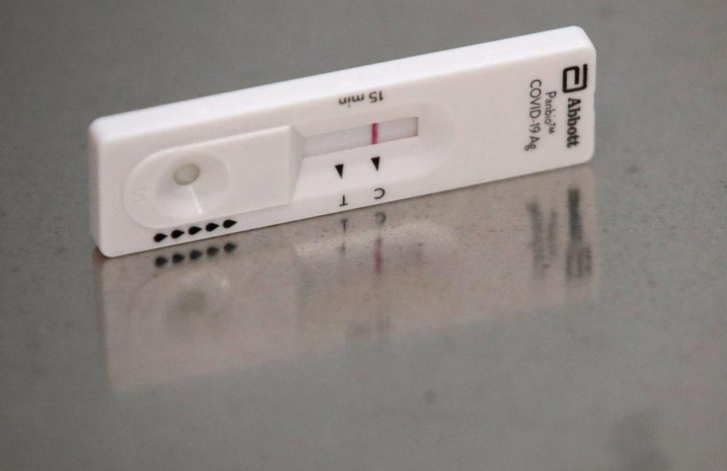With rapid COVID-19 tests, a positive is a positive but a negative result one day is not a guarantee you don’t have the virus, or won’t spread it to others at a later date, experts caution.
If you plan on taking a rapid COVID test for peace of mind before heading to a holiday party or family dinner this week, experts urge you not to drop your guard if you see a negative result.
Rapid tests are reliable when they come back positive, experts say. A negative result, on the other hand, could mean several things — none of which guarantee you don’t have COVID, or won’t spread it.

“With a rapid test, a positive is a positive,” said Dr. Eric Arts, a virologist and immunology professor at Western University. “A negative is not a definitive negative. You may still be infected, regardless of what the rapid test shows you.”
He added: “A sense of security doesn’t exist,”
For one, a negative rapid test result could be a false negative. That happens more often with rapid tests than the PCR tests done at assessment centres, which are more accurate but still not infallible.
It could also be the result of improper sample collection — it’s common for people to miss the part of their nose or upper respiratory tract the virus is replicating while taking a swab, Arts said.
It’s also not uncommon for people infected with COVID-19 — even displaying symptoms such as fever, cough, tiredness and loss of taste or smell — to test negative for days before later testing positive.
All this applies to double or even triple-vaccinated people, too. Vaccines no longer offer the same protection against being infected by the Omicron variant as with previous variants.
Whereas fully vaccinated people had about 95 per cent protection against infection with Delta and previous virus strains, triple-vaccinated people today only have about 70 per cent protection against Omicron. That same share is much less for people with two doses, although two doses still offer significant protection against serious illness.
“The Omicron variant has evolved to escape our immune system, and to some extent escape the vaccine,” Arts said. “You have to be cautious. The exposure risk is very high right now. When we hear about there being more than 3,000 (COVID-19) cases in Ontario right now, it’s probably triple that, if not more.”
Arts said those with access to rapid tests shouldn’t stop taking after a negative result if they are still going out around other people and particularly if they are feeling ill — in which case they should stay home regardless.
“You need to continue to take rapid tests if you’re going into crowded places and high-risk situations like shopping malls,” said Arts. “You should repeat that rapid test the next day and the next day, especially if you have symptoms.”
The chance that an infected person may test negative for days before later testing positive is why Dr. Irfan Dhalla, co-chair of a federal advisory panel on COVID-19 testing and screening, told the Star Friday that anyone experiencing COVID-like symptoms should self-isolate, regardless of rapid test results.
“A negative result with a rapid antigen test is not a green light,” he said. “There are considerable numbers of false negatives.”
It took Guillaume Blais five rapid and one PCR test before he finally got a positive result after he developed COVID symptoms following a Friday-night party earlier this month.
“I tested myself on Saturday and the test came back negative, tested again on Sunday, negative,” he said.
“On Monday, I started to get light cold symptoms, essentially a sore throat and a little bit of a headache. Had another rapid test — negative. By Tuesday, I was sure I was sick, but I tested negative again. That same day, I found out someone at the party was COVID positive.”
Blais booked a PCR test Wednesday, which returned yet another negative result. By that point, Blais assumed he was in the clear. His symptoms were even getting better. Friday night, he took a final rapid test before a board game night with friends.
“Lo and behold, it came back positive, and so did the next test I took,” he said. “I’ve been isolating and testing positive every day since.”
As epidemiologist Dr. Michael Mina explained on Twitter last week, vaccinated individuals like Blais, might initially test negative despite having COVID because, with Omicron, symptoms may be presenting earlier, before the individual becomes contagious and the virus becomes more easily detected.
Previously, COVID was observed to be transmissible before symptoms emerged. Now, COVID may be starting to behave like other respiratory viruses — in people whose immunity has been strengthened by vaccines — and make them sick before they can spread it.
Still, people need to be careful, Mina wrote.
“If you are symptomatic and negative — although it means you’re probably not contagious at that moment, be very, very cautious,” he said. “Quarantine even if possible and test the next morning or that night. (Sometimes even longer.)
“With Omicron, the virus is growing even faster than before so please do take precautions if you have symptoms. Listen to your symptoms for a reasonable amount of time and retest even daily if possible.”
Dr. David Fisman, physician and professor of epidemiology at the University of Toronto, explained that rapid tests are more likely to return false-negative results in people with low viral loads — in other words, people are less likely to spread the virus at the same time that they’re likely to test negative.
Unvaccinated and vaccinated people with COVID can be equally contagious to those around them, but vaccinated people become non-infectious quicker, he added.
That’s “great news,” he said, because the risk an infected person poses to those around them is dependent on both how contagious they are and how long they stay contagious.
Article From: The Star
Author: Ben Cohen

